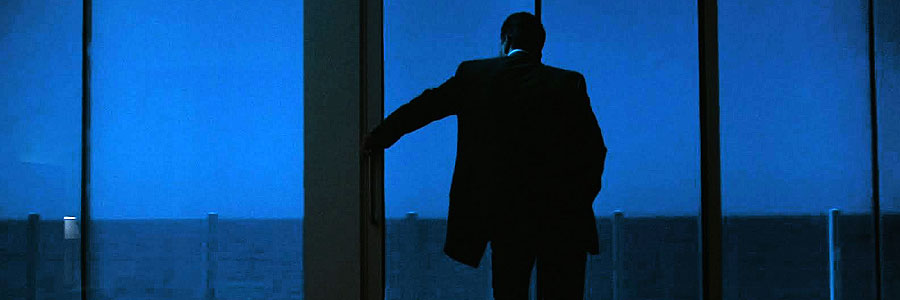
Heat

HEAT (MOVIE)
Warner Bros
Original release: December 15th, 1995
Running time: 107 minutes
Writer and director: Michael Mann
Cast: Robert DeNiro, Al Pacino, Val Kilmer, Tom Sizemore
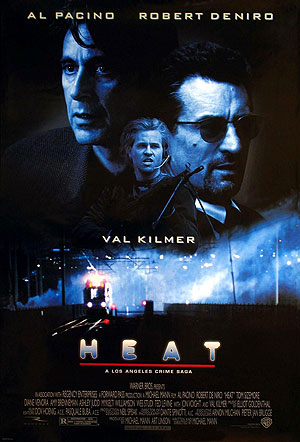
There’s something about seeing ‘that’ film at the cinema. Not as a re-release, the magic and influence has already been instilled, I mean fresh, the shock of the new. You’re sitting there in a darkened room, the image looming over you and you experience what you imagine it was like to see The Great Train Robbery on release, or King Kong, or 2001. Sure there are films that’ve influenced me more, most viewed on late night telly or fuzzy VHS, but Heat was ‘that’ cinema moment for me.
I saw it a few weeks after it came out, deep in 1996 at a Showcase next to a swamp of flyovers, junctions, retail parks and warehouses, in retrospect an entirely fitting place to view one of the great ‘city’ films. I remember seeing the poster some weeks before and being struck by its classic nature; it looked like a poster for one of those great Technicolor epics like Ben Hur or Quo Vadis. Tales of history, conflict and religion, but with a topping of epic set pieces and meaty acting….I was soon to find out this was an accurate assumption.
There was another thing that struck me about the poster…well what at the time struck everyone who saw it, DeNiro and Pacino together; this may not mean much in 2013, but in 1995…get out of here! This is a wind up….in the same film, we shouted…what about The Godfather Part II, they replied…. at the same time, we responded. Yeah the two towering behemoths of modern acting together, remember this was before they’d hit their ‘we’re just working men’ latter career (not a dig, man’s gotta eat…but all I’m saying is Rocky And Bullwinkle). DeNiro had hit a mid-period run that included Goodfellas, Cape Fear, Mad Dog And Glory, A Bronx Tale and Casino, Pacino Glengarry Glen Ross and Carlito’s Way, it was genuinely exciting that they were together.
So all in all even before the film had started there was a texture to the air that I’d never experienced in the cinema before and it only grew after watching the film, so much so that I was back in the same cinema watching it again the week after.
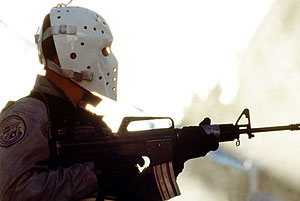
It’s difficult to pin down exactly the reason Heat had this effect. Films are often boiled down to particular quantities….such as the actors (this season’s flavour, are they against type? are they nude!), the plot (especially if it’s something topical or controversial), sometimes the director (Tarantino is bigger than his films), the characters (superheros); this makes it an easier package for our ever decreasing patience, it often overweighs the fact that above all other art forms film is a sum of a multitude of parts, all skilfully overlaid and interwoven to appear as one.
Heat is very much a sum of multiple and exquisitely entwined parts, even though it’s full of acting heavyweights and peerless set pieces (the best gunfight ever….don’t believe me, ask the U.S Marines) they never seem disparate to the film as a whole, they are complementary, an equal part of plot, tone, colour, edit, sound, score, composition, philosophy. Moreover this makes it a supremely poetic film, more poetic for the fact that something like Heat is not meant to be poetic. Mann brings that probing, wandering, wounded masculinity to the film that was the forte of Peckinpah or Huston before him. But even though this is very much a violent, vengeful man’s world, it is never to the detriment of the film’s female characters; in fact Diana Vernora, Amy Brenneman and Ashley Judd emphasize a vital theme of the picture, McCauley‘s and Hanna’s complementary nature; their ‘different sides of the same coin’ bond, by its very nature means that these men cannot construct and hold together normal relationships and the women in the film are the natural causalities of this. They’re hardly one-note either; although Ashley Judd is very much a victim of her husband’s trade, Verona takes control of a situation she knows is doomed and her speech to Pacino in the empty restaurant is one of the overlooked highlights of the film.
The cycles of violence and vengeance and the empty ideas of honour demonstrated by the film’s male characters gives the film that classic feel I first picked up on in the poster, in fact there is a 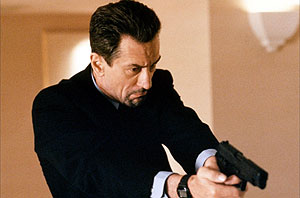 feeling that these conflicts are a never ending cycle, villain kills cop, villain kills villain, cop kills villain, and could be transported into any time and place fairly untouched. The men and their actions are timeless, archetypical symbols. The intricate planning, the ritual, the codes, the details…like the lack of distraction from McCauley‘s empty apartment and prison yard ethos to Sizemore’s abrupt shutting up of Waingro before the film’s opening hold-up. The job is all.
feeling that these conflicts are a never ending cycle, villain kills cop, villain kills villain, cop kills villain, and could be transported into any time and place fairly untouched. The men and their actions are timeless, archetypical symbols. The intricate planning, the ritual, the codes, the details…like the lack of distraction from McCauley‘s empty apartment and prison yard ethos to Sizemore’s abrupt shutting up of Waingro before the film’s opening hold-up. The job is all.
A fine ensemble carry the weight of these lofty, subliminal themes, and even though DeNiro and Pacino’s shadow looms long over the picture, they are all unanimously note perfect in their execution. Kilmer’s muted vulnerability, Sizemore’s impeccably stoic hardman (check the look he gives a curious customer during McCauley‘s diner assault on Waingro to see that there’s a fine mix of performance and reality about him) and the list continues of immediately recognisable character actors filling even the smallest role with nuance and subtle signs of relationship and character….William Fitchner, Danny Trejo, Jon Voight, Tom Noonan, Wes Studi, Ted Levine, Dennis Haysbert, Kevin Gage, Hank Azaria
The beating poetic heart of the film came for me from two areas that complement each other perfectly without overtly drawing attention to the fact (in fact for a film of at times such bombast it is very subtle) the city and the dialogue. The dialogue, minimal like the adversaries’ 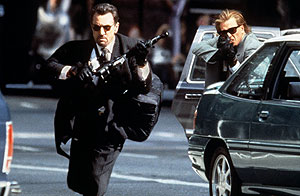 apartments, spoken by men who do not waste a word, echoes with the rhythm of Hemingway and Elroy, a form of stylised speech that appears naturalistic, mixing slang and untranslated technical speech with an internal rhythm, a ‘bounce’, that feels very urban, familiar to both city dwellers and regulars to cop films and TV, but also exotic in the fact these people are so far away from anyone we are likely to know in our lives (though there was a real Neil McCauley and his adversary Vincent Hanna was in reality Detective Chuck Adamson).
apartments, spoken by men who do not waste a word, echoes with the rhythm of Hemingway and Elroy, a form of stylised speech that appears naturalistic, mixing slang and untranslated technical speech with an internal rhythm, a ‘bounce’, that feels very urban, familiar to both city dwellers and regulars to cop films and TV, but also exotic in the fact these people are so far away from anyone we are likely to know in our lives (though there was a real Neil McCauley and his adversary Vincent Hanna was in reality Detective Chuck Adamson).
Again though the dialogue never ‘bounces’ detrimentally to the forefront, low in the mix it becomes another sound in the cityscape. Complemented by a score that superbly evokes the geometry of the city and fills the gaps between words, from the opening wave of synth, ambient tones imply space and isolation, tension comes from the orchestral swells, menace from the sparse, effective use of huge percussion, reverbing off the empty, midnight walls of industry and freeways.
LA through Mann’s eye has a Ballardian urban fetish, both visually and verbally, there’s as much talk of freeways and architecture as there is physicality. There’s a psycho-geographical element to much of Mann’s films but particularly Heat, no soundstages, everything a visceral reality, humming with chatter, electricity and the great expanses of nocturnal urban space. The protagonists move through the city streets in tandem with their conflicts and we move through their narratives and evolution …city, action and character become one, intertwined, intangible.
It is overall a geography of forbidden places from the opening shots of rail tracks to the climatic chase along the airport runway. Both cop and criminal dwarfed by the towering structures of men and therefore, inevitably after such a Shakespearean conflict, they’re shown their undeniably insignificant place in things, the city and the cities beyond carry on long after the shooting.
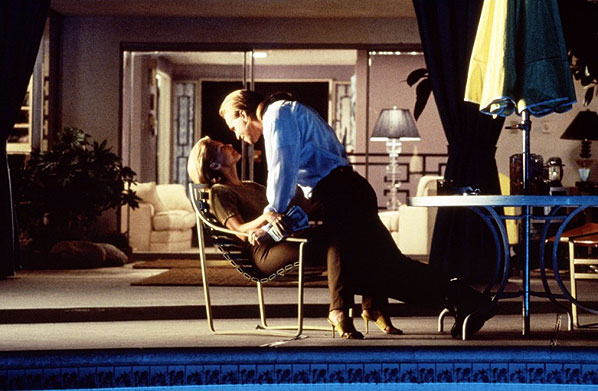

Ben Cook
Ben has been in love with cinema from a young age having been introduced to the classic cinema of Capra and Hitchcock by his father and the ‘other’ classic cinema of Carpenter and Cronenberg by Alex Cox late night on Channel 4.
In 2009 with formal training that equated to watching Mean Streets a lot, he co-founded Anti/Type Films. Since then he has written, produced and directed more than a dozen short films and documentaries, as well as writing and performing several scores. It means he gets to travel, which he likes.
He has his own site www.antitypefilms.co.uk and you can follow him on Twitter @AntiTypeFilms.
© 2022 STATIC MASS EMPORIUM . All Rights Reserved. Powered by METATEMPUS | creative.timeless.personal. | DISCLAIMER, TERMS & CONDITIONS
HOME | ABOUT | CONTACT | TWITTER | GOOGLE+ | FACEBOOK | TUMBLR | YOUTUBE | RSS FEED
CINEMA REVIEWS | BLU-RAY & DVD | THE EMPORIUM | DOCUMENTARIES | WORLD CINEMA | CULT MOVIES | INDIAN CINEMA | EARLY CINEMA
MOVIE CLASSICS | DECONSTRUCTING CINEMA | SOUNDTRACKS | INTERVIEWS | THE DIRECTOR’S CHAIR | JAPANESE CINEMA





